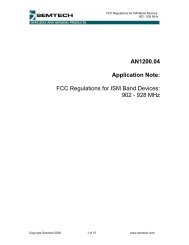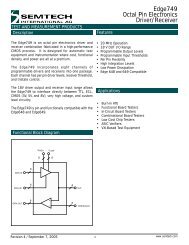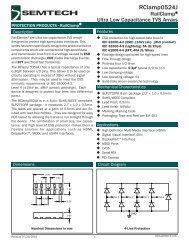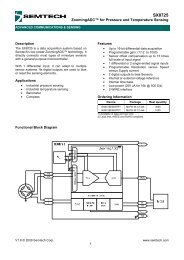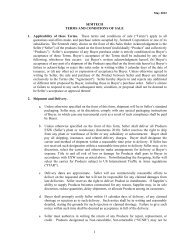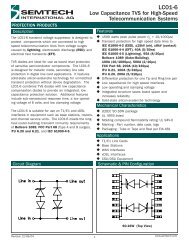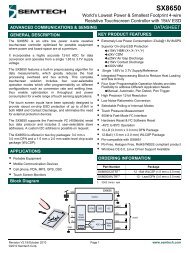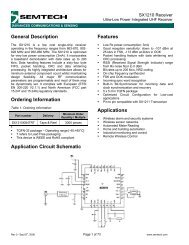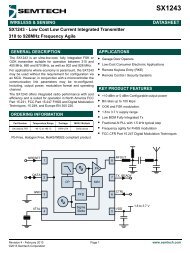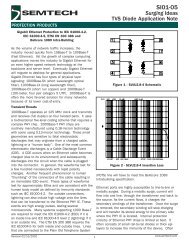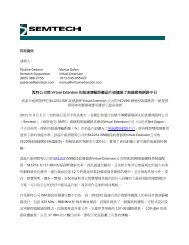Low Cost, Dual-Channel, 15V Pin Electronics Driver ... - Semtech
Low Cost, Dual-Channel, 15V Pin Electronics Driver ... - Semtech
Low Cost, Dual-Channel, 15V Pin Electronics Driver ... - Semtech
Create successful ePaper yourself
Turn your PDF publications into a flip-book with our unique Google optimized e-Paper software.
E7802<br />
TEST AND MEASUREMENT PRODUCTS<br />
Circuit Description<br />
Description<br />
The E7802 supports independently programmable driver<br />
high and low levels as well as tristate per channel. There<br />
are no shared lines between the two drivers. The EN and<br />
DATA signals are inputs that are used to control the output<br />
of the driver as shown in Table 1. Each channel of the<br />
E7802 features a window comparator with separate high<br />
and low threshold levels (CVH, CVL), as well as independent<br />
digital outputs (QH, QL).<br />
EN DATA DOUT<br />
0 0 HiZ<br />
0 1 HiZ<br />
1 0 VL<br />
1 1 VH<br />
Table 1. <strong>Driver</strong> Functionality<br />
NOTE: The voltage at DOUT needs to stay at DVEE < DOUT<br />
< VCC at all times (HiZ/Active).<br />
Drive High and <strong>Low</strong><br />
<strong>Driver</strong> Output Protection<br />
The E7802’s drivers feature short circuit protection circuitry<br />
that prevents them from being damaged in the event of a<br />
short circuit at their outputs. In the event of a short circuit<br />
at the driver output and short circuit protection is enabled<br />
(SCP*=0), DOUT will place itself in a high impedance state<br />
and the comparator outputs, QH and QL, are designed to<br />
both assert a Logic “0” to indicate that a short circuit event<br />
has occurred. In addition to the comparator outputs pulling<br />
down, the INT* pin will become active (pull-down) when<br />
either channel detects a s hort-circuit condition. Multiple<br />
E7802 INT* pins may be wire-or’d together with a single<br />
VDD pull-up load to create a system-wide notification signal<br />
that a short circuit has occurred on one of the chanels in<br />
the system. After a short circuit event has occurred, the<br />
driver can be reset to the active state by toggling the EN<br />
pin from Logic “0” to Logic “1” .<br />
Either after power-up or after short circuit protection is<br />
enabled, the EN pin needs to be toggled from Logic “0” to<br />
Logic “1” to allow the driver to power up in the active state<br />
and ensure the short circuit protection is reset for proper<br />
operation (see Timing Diagram below).<br />
short circuit occurs<br />
VH and VL define the logical “1” and “0” levels of the driver,<br />
and can be adjusted to produce driver output swings from<br />
200mV up to <strong>15V</strong>.<br />
DOUT<br />
QH<br />
Valid Comp. Output<br />
Tri-state<br />
The VH and VL inputs are unbuffered. They provide the<br />
driver output current (see Figure 1), so the source of VH<br />
and VL must have ample current drive capability. (See<br />
Applications Note PE-A1).<br />
QL<br />
INT*<br />
Valid Comp. Output<br />
VH<br />
EN<br />
DATA<br />
EN<br />
<strong>Driver</strong> Logic<br />
VL<br />
DOUT<br />
T INT*<br />
Because of the nature of the SCP circuit design, it is<br />
recommended that the user have SCP enabled only under<br />
the valid SCP operating zone. Refer to Figure 2 for the<br />
conditions.<br />
Toe<br />
Figure 1.<br />
© 2008 <strong>Semtech</strong> Corp. , Rev. 5, 3/7/08<br />
<br />
www.semtech.com



